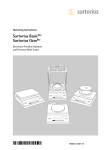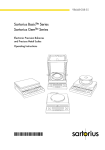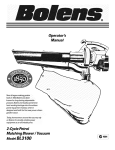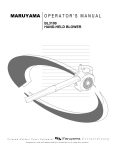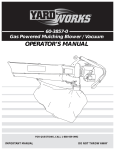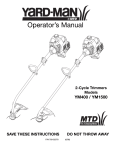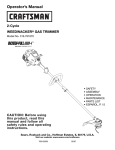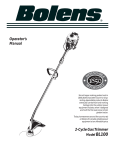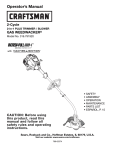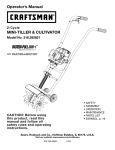Download Bolens BL3100 Operator`s manual
Transcript
Operator’s Manual Since it began making garden tools in 1850, Bolens has been known for long-lasting, dependable products. Bolens eventually carried that hard-working heritage into the outdoor power equipment industry, when it designed and built the first-ever power-driven garden tractor. Today, homeowners around the country rely on Bolens for durable, reliable power equipment at an affordable price. 2-Cycle Petrol Mulching Blower / Vacuum Model BL3100 INTRODUCTION THANK YOU TABLE OF CONTENTS Thank you for buying this quality product. This modern outdoor power tool will provide many hours of useful service. You will find it to be a great labor-saving device. This operator’s manual provides you with easy-tounderstand operating instructions. Read the whole manual and follow all the instructions to keep your new outdoor power tool in top operating condition. PRODUCT REFERENCES, ILLUSTRATIONS AND SPECIFICATIONS All information, illustrations and specifications in this manual are based on the latest product information available at the time of printing. We reserve the right to make changes at any time without notice. Copyright© 2003 MTD SOUTHWEST INC All Rights Reserved. Service Information . . . . . . . . . . . . . . . . . . . . . . . . .2 Rules for Safe Operation . . . . . . . . . . . . . . . . . . . . .3 Know Your Unit . . . . . . . . . . . . . . . . . . . . . . . . . . . .7 Assembly Instructions . . . . . . . . . . . . . . . . . . . . . . .8 Oil and Petrol Information . . . . . . . . . . . . . . . . . . .10 Starting/Stopping Instructions . . . . . . . . . . . . . . . .11 Operating Instructions . . . . . . . . . . . . . . . . . . . . . .12 Maintenance and Repair Instructions . . . . . . . . . . .15 Cleaning and Storage . . . . . . . . . . . . . . . . . . . . . . .18 Accessories and Replacement Parts . . . . . . . . . . .18 Troubleshooting Chart . . . . . . . . . . . . . . . . . . . . . .19 DO NOT RETURN THE UNIT TO THE RETAILER. NOTE: PROOF OF PURCHASE WILL BE REQUIRED FOR WARRANTY SERVICE. Specifications . . . . . . . . . . . . . . . . . . . . . . . . . . . . .20 Warranty Information . . . . . . . . . . . . . . . . . . . . . . .24 Parts List . . . . . . . . . . . . . . . . . . . .Inside Back Cover MODEL : S/N : ITEM : CONTENTS OF CARTON This unit includes the following: • Model BL3100 Mulching Blower Vacuum • Blower/Vacuum Tube • Vacuum bag Copy the model / parent part number here: • Shoulder Strap • Patio Head • Hardware Pack Copy the serial number here: • Bottle of 2-Cycle Oil • Operator's Manual Make sure you carefully read and understand this manual before starting or operating this equipment. THIS PRODUCT IS COVERED BY ONE OR MORE US PATENTS, OTHER PATENTS PENDING. 2 Examine all parts to make certain that nothing is missing and no breakage has occurred during shipping. Any damaged or missing part must be replaced before using this product. CALIFORNIA PROPOSITION 65 WARNING WARNING THE ENGINE EXHAUST FROM THIS PRODUCT CONTAINS CHEMICALS KNOWN TO THE STATE OF CALIFORNIA TO CAUSE CANCER, BIRTH DEFECTS OR OTHER REPRODUCTIVE HARM. SPARK ARRESTOR NOTE: For users on U.S. Forest Land and in the states of California, Maine, Oregon and Washington. All U.S. Forest Land and the state of California (Public Resources Codes 4442 and 4443), Oregon and Washington require, by law that certain internal combustion engines operated on forest brush and/or grass-covered areas be equipped with a spark arrestor, maintained in effective working order, or the engine be constructed, equipped and maintained for the prevention of fire. Check with your state or local authorities for regulations pertaining to these requirements. Failure to follow these requirements could subject you to liability or a fine. This unit is factory equipped with a spark arrestor. If it requires replacement, ask your LOCAL SERVICE DEALER to install the Accessory Part #182747 Spark Arrestor Kit. WARNING! Read the Operator’s Manual(s) and follow all warnings and safety instructions. Failure to do so can result in serious injury to the operator and/or bystanders. RULES FOR SAFE OPERATION The purpose of safety symbols is to attract your attention to possible dangers. The safety symbols, and their explanations, deserve your careful attention and understanding. The safety warnings do not by themselves eliminate any danger. The instructions or warnings they give are not substitutes for proper accident prevention measures. NOTE: Advises you of information or instructions vital to the operation or maintenance of the equipment. SYMBOL MEANING SAFETY ALERT SYMBOL: Indicates danger, warning or caution. Attention is required in order to avoid serious personal injury. May be used in conjunction with other symbols or pictographs. SYMBOL MEANING DANGER: Failure to obey a safety warning will result in serious injury to yourself or to others. Always follow the safety precautions to reduce the risk of fire, electric shock and personal injury. WARNING: Failure to obey a safety warning can result in injury to yourself and others. Always follow the safety precautions to reduce the risk of fire, electric shock and personal injury. CAUTION: Failure to obey a safety warning may result in property damage or personal injury to yourself or to others. Always follow the safety precautions to reduce the risk of fire, electric shock and personal injury. 3 RULES FOR SAFE OPERATION • IMPORTANT SAFETY INFORMATION • READ ALL INSTRUCTIONS WHILE OPERATING BEFORE OPERATING • Never start or run the unit inside a closed room or building. Breathing exhaust fumes can kill. Operate this unit only in a well-ventilated outdoor area. WARNING: When using the unit, you must follow the safety rules. For your own safety and that of bystanders, please read these instructions before operating the unit. Please keep the instructions for later use. • Read the instructions carefully. Be familiar with the controls and proper use of the unit. • Do not operate this unit when tired, ill, or under the influence of alcohol, drugs, or medication. • Children and teens under the age of 15 must not use the unit, except for teens guided by an adult. • All guards and safety attachments must be installed properly before operating the unit. • Inspect the unit before use. Replace damaged parts. Check for petrol leaks. Make sure all fasteners are in place and secure. Replace parts that are cracked, chipped, or damaged in any way. Do not operate the unit with loose or damaged parts. • Carefully inspect the area before starting the unit. Remove all debris and hard or sharp objects such as glass, wire, etc. • Clear the area of children, bystanders, and pets. At a minimum, keep all children, bystanders, and pets outside a 15 m (50 feet) radius; there still may be a risk to bystanders from thrown objects. Bystanders should be encouraged to wear eye protection. If you are approached, stop the unit immediately. SAFETY WARNINGS FOR PETROL UNITS WARNING: Petrol is highly flammable, and its vapors can explode if ignited. Take the following precautions: • Store petrol only in containers specifically designed and approved for the storage of such materials. • Avoid creating a source of ignition for spilled petrol. Do not start the engine until petrol vapors dissipate. • Always stop the engine and allow it to cool before filling the petrol tank. Never remove the cap of the petrol tank, or add petrol, when the engine is hot. Never operate the unit without the petrol cap securely in place. Loosen the petrol tank cap slowly to relieve any pressure in the tank. • Mix and add petrol in a clean, well-ventilated outdoor area where there are no sparks or flames. Slowly remove the petrol cap only after stopping engine. Do not smoke while fueling or mixing petrol. Wipe up any spilled petrol from the unit immediately. Always wipe unit dry before using. • Move the unit at least 9.1 m (30 feet) from the fueling source and site before starting the engine. Do not smoke or allow sparks and open flames near the area while adding petrol or operating the unit. 4 • To reduce the risk of injury associated with thrown objects, wear safety glasses or goggles that are marked as meeting ANSI Z87. standards. • Never run the unit without the the proper equipment attached. When using this unit, always install the blower/vacuum tubes and vacuum bag depending on model. Make sure the vacuum bag is completely zipped closed. • To reduce the risk of hearing loss associated with sound level(s), always wear ear/hearing protection when operating this unit. • Wear heavy, long pants, boots, and gloves. Do not wear short pants, sandals, or go barefoot. • To avoid static electricity shock, do not wear rubber gloves or any other insulated gloves while operating this unit. • To reduce the risk of injury associated with objects being drawn into rotating parts, do not wear loose clothing, jewelry, scarves, and the like. Secure hair above shoulder level. • Wear a face or dust mask if the operation is dusty. Long sleeve shirts are recommended. • Use the unit only in daylight or good artificial light. • Keep outside surfaces free from oil and petrol. • Avoid accidental starting. Be in the starting position whenever pulling the starter rope. The operator and unit must be in a stable position while starting. Refer to Starting/Stopping Instructions. • Do not set unit on any surface except a clean, hard area while engine is running. Debris such as gravel, sand, dust, grass, etc. could be picked up by the air intake and thrown out by the discharge opening, damaging unit, property, or causing serious injury to bystanders or operator. • Use the right tool. Only use this tool for the purpose intended. • Do not force unit. It will do the job better and with less likelihood of injury at a rate for which it was designed. • Do not overreach or use from unstable surfaces such as ladders, trees, steep slopes, rooftops, etc. Always keep proper footing and balance. • Always hold the unit with a firm grip when operating. • Keep hands, face, and feet at a distance from all moving parts. Do not touch or try to stop the impeller when it is rotating. Do not operate without guards in place. • Do not put any object into openings. Do not use with any opening blocked; keep free of dirt, debris, and anything that may reduce the air flow. RULES FOR SAFE OPERATION • Do not touch the engine or muffler. These parts get extremely hot from operation. When turned off they remain hot for a short time. • Do not operate the engine faster than the speed needed to do the job. Do not run the engine at high speed when not in use. • Always stop the engine when operation is delayed or when walking from one location to another. • Stop the engine for maintenance, repair, to install or remove the blower tubes or vacuum attachments. The unit must be stopped and the impeller no longer turning to avoid contact with the rotating blades. • The unit is designed to pickup dry material such as leaves, grass, small twigs, and bits of paper. Do not attempt to vacuum wet debris and/or standing water as this may result in damage to the blower/ vacuum. To avoid severe damage to the impeller, do not vacuum metal, broken glass, etc. OTHER SAFETY WARNINGS • Always disconnect the spark plug before performing maintenance or accessing movable parts. • Never store the unit, with petrol in the tank, inside a building where fumes may reach an open flame (pilot lights, etc.) or sparks (switches, electrical motors, etc.). • Use only original equipment manufacturer replacement parts when servicing this unit. These parts are available from your authorized service dealer. Do not use unauthorized parts, accessories, or attachments for this unit. Doing so could lead to serious injury to the user, or damage to the unit, and void your warranty. • Allow the engine to cool before storing or transporting. Be sure to secure the unit while transporting. • Never use this unit for spreading chemicals, fertilizers or other substances which may contain toxic materials. • Never douse or squirt the unit with water or any other liquid. Keep handles dry, clean, and free from debris. Clean after each use, see Cleaning and Storage instructions. • To reduce fire hazard, replace faulty muffler and spark arrestor, keep the engine and muffler free from grass, leaves, excessive grease or carbon build up. WHILE OPERATING UNIT AS A BLOWER • Never point the blower in the direction of people or pets, or in the direction of windows. Always direct the blowing debris away from people, animals, and windows. Use extra caution when blowing debris near solid objects such as trees, automobiles, walls, etc. WHILE OPERATING UNIT AS A VACUUM • Avoid situations that could catch the vacuum bag on fire. Do not operate near an open flame. Do not vacuum warm ash from fireplaces, barbecue pits, brush piles, etc. Do not vacuum discarded cigars or cigarettes unless the cinders are completely cool. • Store the unit in a dry place, either locked up or up high to prevent unauthorized use or damage. Keep out of the reach of children. • Keep these instructions. Refer to them often and use them to instruct other users. If you loan this unit to others, also loan these instructions to them. SPECIAL NOTE: Exposure to vibrations through prolonged use of petrol powered hand tools could cause blood vessel or nerve damage in the fingers, hands, and joints of people prone to circulation disorders or abnormal swelling. Prolonged use in cold weather has been linked to blood vessel damage in otherwise healthy people. If symptoms occur such as numbness, pain, loss of strength, change in skin color or texture, or loss of feeling in the fingers, hands or joints, discontinue use of this tool and seek medical attention. An anti-vibration system does not guarantee avoidance of these problems. Users who operate power tools on a regular basis must closely monitor their physical condition and the condition of this tool. SAVE THESE INSTRUCTIONS 5 RULES FOR SAFE OPERATION SAFETY AND INTERNATIONAL SYMBOLS This operator's manual describes safety and international symbols and pictographs that may appear on this product. Read the operator's manual for complete safety, assembly, operating and maintenance and repair information. SYMBOL MEANING • SAFETY ALERT SYMBOL Indicates danger, warning, or caution. May be used in conjunction with other symbols or pictographs. SYMBOL MEANING • ON/OFF STOP CONTROL ON / START / RUN • ON/OFF STOP CONTROL • WARNING - READ OPERATOR'S MANUAL Read the Operator’s Manual(s) and follow all warnings and safety instructions. Failure to do so can result in serious injury to the operator and/or bystanders. OFF or STOP • HOT SURFACE WARNING Do not touch a hot muffler or cylinder. You may get burned. These parts get extremely hot from operation. When turned off they remain hot for a short time. • WEAR EYE AND HEARING PROTECTION WARNING: Thrown objects and loud noise can cause severe eye injury and hearing loss. Wear eye protection meeting ANSI Z87.1-1989 standards and ear protection when operating this unit. Use a full face shield when needed. • KEEP BYSTANDERS AWAY WARNING: Keep all bystanders, especially children and pets, at least 15 m (50 feet) from the operating area. • UNLEADED PETROL Always use clean, fresh unleaded petrol. • OIL Refer to operator's manual for the proper type of oil. • THROWN OBJECTS AND ROTATING CUTTER CAN CAUSE SEVERE INJURY WARNING: Keep clear of blower outlet. Never point the blower at yourself or others. Objects can be thrown from blower. Do not operate unit without proper attachments and guards in place. 6 • CHOKE CONTROL A • FULL choke position. B • PARTIAL choke position. C • RUN position. • BLOWERS – ROTATING IMPELLER BLADES CAN CAUSE SEVERE INJURY WARNING: Stop the engine and allow the impeller to stop before opening the vacuum door, installing or changing tubes or bag, or before cleaning or performing any maintenance. • BLOWER/VACUUM MODE CHANGE-OVER LEVER A - Vacuum mode B - Blower mode • THROTTLE CONTROL Indicates “HIGH” or “FASTEST” speed. • THROTTLE CONTROL Indicates “IDLE”, “LOW” or “SLOWEST” speed. RULES FOR SAFE OPERATION KNOW YOUR UNIT Throttle Control APPLICATION As a blower: • Cleaning yards, garages, driveways, porches, patios, around walls, fences and more As a vacuum: • Picking up leaves and other light debris Petrol Cap Starter Rope Grip On/Off Stop Control Blower/Vacuum Tube Shoulder Harness Vacuum Inlet Blower Outlet Vacuum Bag Hook Blower/Vacuum Mode Change-Over Lever Spark Plug Vacuum Bag Choke Control Vacuum Bag Zipper Primer Air filter/muffler cover Patio Head Muffler 7 ASSEMBLY INSTRUCTIONS ATTACHING AND REMOVING THE BLOWER/VACUUM TUBE WARNING: To avoid serious personal injury, the blower/vacuum tube and vacuum bag must be used when operating this unit. Removing NOTE: It may be necessary to remove the Blower/Vacuum Tube to clear a blocked tube or impeller. WARNING: To prevent serious personal injury, stop the engine and allow the impeller to stop before attaching or removing tubes. Attaching NOTE: The Blower/Vacuum Tube comes unassembled on this unit. Installation is required to provide safe and easy use for the operator. WARNING: To prevent serious personal injury, stop the engine and allow the impeller to stop before attaching or removing tubes. 1. Remove the 2 (two) self-tapping screws from either side of the housing. 2. Remove the 2 (two) screws and nuts holding the blower/vacuum tube on the housing (Fig. 2). NOTE: Keep the hardware in a safe place for future use. 1. Remove the screws and nuts provided from the hardware pack. 2. Insert the blower/vacuum tube all the way into the opening on the motor housing until the holes in the tabs on the blower/vacuum tube align with the screw holes in the housing (Fig. 1). 3. Insert the 2 (two) 8-32 x 3/4” slotted T20 Torx screws into the right side of the motor housing and the 2 (two) nuts into the left side of the motor housing (Fig. 1). Motor Housing Nut Blower/Vacuum Tube Screw and Nut Self Tapping Screw Screw and Nut Fig. 2 3. Remove the blower/vacuum tube from the motor housing. 4. Replace Blower/Vacuum Tube before use. Screw Self-Tapping Screw Fig. 1 4. Tighten the screws firmly. Do not over-tighten. 5. Install the 2 (two) remaining self-tapping 8-16 x 3/4” slotted T20 Torx screws into the holes on either side of the housing (Fig. 1). Tighten until snug, do not over-tighten. 8 ASSEMBLY INSTRUCTIONS ATTACHING AND REMOVING THE VACUUM BAG INSTALLING THE SHOULDER HARNESS Attaching WARNING: To avoid serious personal injury, never attempt to start the unit when standing, when the unit is clipped to the shoulder strap. Always follow the starting procedures as described in the Starting/ Stopping Instructions section. 1. Attach the vacuum bag to the vacuum bag hook on the blower/vacuum tube (Fig. 3). 1. Push the strap through the center of the buckle. 2. Pull the strap over the cross bar and down through the slot in the buckle (Fig. 6). Vacuum Bag Hook Fig. 3 2. Slide the vacuum bag tube over the debris exhaust tube on the housing. Push the tube until the latching tabs on both sides click into place, securing the bag on the unit (Fig. 4). Clip Fig. 6 3. Snap the clip on to the support fitting (Fig. 7). Latching Tabs Debris Exhaust Tube Support Fitting Vacuum Bag Tube Vacuum Bag Zipper Fig. 4 Clip Removing 1. Press the latching tabs on both sides of the vacuum bag tube and pull the vacuum bag down from the unit (Fig. 5). 2. Detach the vacuum bag from the vacuum bag hook. Fig. 7 4. While standing in the operating position adjust length to fit the operator’s size. Pull tab to lengthen, pull strap to shorten (Fig 8). Latching Tabs PRESS IN PRESS IN Fig. 5 Fig. 8 9 OIL AND PETROL INFORMATION OIL AND PETROL MIXING INSTRUCTIONS Old and/or improperly mixed petrol are the main reasons for the unit not running properly. Be sure to use fresh, clean unleaded petrol. Follow the instructions carefully for the proper petrol/oil mixture. Definition of Blended Petrols Today's petrols are often a blend of petrol and oxygenates such as ethanol, methanol, or MTBE (ether). Alcohol-blended petrol absorbs water. As little as 1% water in the petrol can make petrol and oil separate. It forms acids when stored. When using alcohol-blended petrol, use fresh petrol (less than 60 days old). Thoroughly mix the proper ratio of 2-cycle engine oil with unleaded petrol in a separate petrol can. Use a 40:1 petrol/oil ratio. Do not mix them directly in the engine petrol tank. See the table below for specific petrol and oil mixing ratios. NOTE: 3.8 liters (1 US gallon) of unleaded petrol mixed with one 95 ml (3.2 oz) bottle of 2-cycle oil makes a 40:1 petrol/oil ratio. + Using Blended Petrols If you choose to use a blended petrol, or its use is unavoidable, follow recommended precautions: • Always use the fresh petrol mix explained in your operator's manual • Always agitate the petrol mix before fueling the unit • Drain the tank and run the engine dry before storing the unit Using Petrol Additives The bottle of 2-cycle oil that came with your unit contains a petrol additive which will help inhibit corrosion and minimize the formation of gum deposits. It is recommended that you use our 2-cycle oil with this unit. If unavailable, use a good 2-cycle oil designed for air-cooled engines along with a petrol additive, such as STA-BIL® Petrol Stabilizer or an equivalent. Add 23 ml (0.8 oz) of petrol additive per gallon of petrol according to the instructions on the container. NEVER add petrol additives directly to the unit's petrol tank. CAUTION: For proper engine operation and maximum reliability, pay strict attention to the oil and petrol mixing instructions on the 2-cycle oil container. Using improperly mixed petrol can severely damage the engine. UNLEADED PETROL 2 CYCLE OIL 3.8 LITERS (1 GALLON US) 95 ml (3.2 FL. OZ) 1 LITER 25 ml MIXING RATIO - 40:1 WARNING: Petrol is extremely flammable. Ignited Vapors may explode. Always stop the engine and allow it to cool before filling the petrol tank. Do not smoke while filling the tank. Keep sparks and open flames at a distance from the area. WARNING: Remove petrol cap slowly to avoid injury from petrol spray. Never operate the unit without the petrol cap securely in place. WARNING: Add petrol in a clean, well ventilated outdoor area. Wipe up any spilled petrol immediately. Avoid creating a source of ignition for spilt petrol. Do not start the engine until petrol vapors dissipate. NOTE: Dispose of the old petrol/oil mix in accordance to Federal, State and Local regulations. 10 STARTING/STOPPING INSTRUCTIONS STARTING INSTRUCTIONS Throttle Control Idle Fast WARNING: Operate this unit only in a wellventilated outdoor area. Carbon monoxide exhaust fumes can be lethal in a confined area. WARNING: Avoid accidental starting. Make sure you are in the starting position when pulling the starter rope (Fig. 11). To avoid serious injury, the operator and unit must be in a stable position while starting. Do not set unit on any surface except a clean, hard area while starting. Debris such as gravel, sand, dust and grass could be picked up by the air intake and thrown out by the discharge opening. This could damage the unit, property, or cause serious injury to bystanders or operator. 1. Mix petrol with oil. Fill petrol tank with petrol/oil mixture. Refer to Oil and Petrol Mixing Instructions. WARNING: To avoid serious personal injury, always remove the vacuum bag prior to refueling the unit. The bag may become a fire hazard when saturated with petrol. On/Off Stop Control Fig. 9 A B Position C Position B Position A Choke Control NOTE: The throttle control will remain in the position it’s placed until moved by the operator. Fast position is to the right. 2. Set the blower/vacuum mode change-over lever to the up position (Blower Mode). See Operating as a Blower. This prevents the vacuum bag from filling up while starting the engine. 3. Fully press and release the primer bulb 10 times, slowly, until PETROL IS VISIBLE IN THE PRIMER BULB (Fig. 10). If you can’t see petrol in the bulb, press and release the bulb as many times as it takes before you can see petrol in it. 4. Place the choke lever in Position A (Fig. 10). C Primer Bulb Fig. 10 Starter Rope 5. Place the unit in the starting position (Fig. 11). Move the throttle control to the fast position ( ) (Fig. 9). 6. Pull the starter rope briskly 5 times. 7. Place the choke lever in Position B. 8. Pull starter rope briskly 1 to 3 times to start the engine (Fig. 11). 9. If the engine does not start, repeat steps 3 through 8. NOTE: If the engine floods while trying to start, place the choke lever in Position C. Move the throttle control to the fast position ( ). Pull the starter rope briskly. The engine should start with three (3) to eight (8) pulls. 10. Allow the engine to warm up up for 5 to 10 seconds. Place the choke lever in Position C. NOTE: Choking is unnecessary when starting a warm engine. Put the throttle control in the fast position ( ) (Fig 9) and start unit with the choke control in Position B. Fig. 11 STOPPING INSTRUCTIONS 1. Move the throttle control to the idle position ( ). Allow the engine to cool down by idling for 10-15 seconds. 2. Press the On/Off Stop control down in the STOP (O) position until the engine comes to a complete stop. 11 OPERATING INSTRUCTIONS HOLDING THE BLOWER/VACUUM Before operating the unit, stand in the operating position. (Fig. 12). Check for the following: • Operator is wearing proper clothing, such as boots, safety glasses or goggles, ear/hearing protection, gloves, long pants and long sleeve shirt WARNING: To avoid serious personal injury, wear goggles or safety glasses at all times when operating this unit. Wear a face mask or dust mask in dusty locations • To reduce noise levels, operate power blowers at the lowest possible speed to do the job. • Check your equipment before operation, especially the muffler, air intakes and air filters. • Use rakes and brooms to loosen debris before blowing. • In dusty conditions, slightly dampen surfaces or use a mister attachment when water is available. • Conserve water by using power blowers instead of hoses for many lawn and garden applications, including areas such as gutters, screens, patios, grills, porches, and gardens. • If the conditions are dusty, the operator is wearing a dust mask or face mask • Watch out for children, pets, open windows or freshly washed cars, and blow debris safely away. • The unit is in good working condition • Use the full blower nozzle extension so the air stream can work close to the ground. • The tubes and guards are in place and secure WARNING: To prevent serious personal injury or damage to the unit, make sure blower tubes or vacuum tubes and the vacuum bag are in place before you operate the unit. OPERATING TIPS • Be sure the vacuum bag is zipped closed before operating the unit. • Assure the unit is not directed at anybody or any loose debris before starting the unit. • Verify that the unit is in good working condition. Make sure the tubes and guards are in place and secure. • Clean up after using blowers and other equipment. Dispose of debris appropriately. OPERATING AS A BLOWER Converting to a Blower 1. Start engine. See Starting/Stopping Instructions. 2. Set the blower/vacuum mode change-over lever to the up position (Blower Mode) (Fig. 13). NOTE: Never use the unit with the lever in a position half way between either mode. 3. Place the shoulder harness over your head and onto your shoulder and adjust it. Refer to Installing the Shoulder Harness. • Always hold the unit with both hands when operating. Keep a firm grip on both the front and rear handle or grips. • To reduce the risk of hearing loss associated with sound level(s), hearing protection is required. • Operate power equipment only at reasonable hours— not early in the morning or late at night when people might be disturbed. Comply with times listed in local ordinances. Usual recommendations are 9:00 am to 5:00 pm, Monday through Saturday. Vacuum Mode Change-over lever Blower Mode • To reduce noise levels, limit the number of pieces of equipment used at any one time. Fig. 13 Blower Operating Procedures Hold the blower as shown in Figures 14, 15, and 16. Sweep from side to side with the nozzle several inches above the ground or floor. Slowly advance the unit, keeping the accumulated pile of debris in front of you. Most dry blowing operations are better suited to low speeds, rather than high. High speed blowing is a better way to move heavier items like large debris or gravel. 1 Use the blower for trees, shrubs, flower beds and hard-to-clean areas (Fig. 14). 2. Use the unit around buildings and for other normal cleaning procedures (Fig. 15). 3. Use the blower around walls, overhangs, fences and screens (Fig. 16). Fig. 12 12 OPERATING INSTRUCTIONS Vacuum Operation Procedures Fig. 15 Fig. 14 Check for the following before operating the unit: • Operator is wearing proper clothing, such as boots, safety glasses or goggles, ear/hearing protection, gloves, long pants and long sleeve shirt • If the conditions are dusty, operator is equipped with a dust mask or face mask • The unit is in good working condition-- the vacuum tubes and vacuum bag are in place and secure. • The vacuum bag harness is in place and adjusted Use the unit for vacuuming up light debris like leaves and paper. Hold the vacuum, tilting the suction tube slightly (50-100 mm or 2-4 inches), and use a sweeping action to collect light debris (Fig. 18). The debris will flow into the vacuum bag. Items such as small leaves and small twigs will be mulched as they pass through the fan housing, allowing the vacuum bag to hold more debris. When the bag is full, suction will noticeably decrease. Turn off the unit and allow the impeller to stop before you unzip the bag. Unzip the bag and empty the contents before continuing. Refer to Emptying the Vacuum Bag. Fig. 16 OPERATING AS A VACUUM Converting to Vacuum 1. Start engine. See Starting/Stopping Instructions. 2. Set the blower/vacuum mode change-over lever to the down position (Vacuum Mode) (Fig. 17). NOTE: Never use the unit with the lever in a position half way between either mode. 3. Place the shoulder harness over your head, onto your shoulder and adjust it if necessary. Refer to Installing the Shoulder Harness. Vacuum Mode Change-over lever Blower Mode Fig. 17 WARNING: To prevent serious personal injury or damage to the unit, always install vacuum tubes, the vacuum bag and make sure the vacuum bag is completely zipped closed when operating this unit as a vacuum. Fig. 18 WARNING: To avoid serious personal injury, never unzip the vacuum bag without stopping the unit first WARNING: As a vacuum, the unit is designed to pick up dry material such as leaves, grass, small twigs and bits of paper. To avoid serious personal injury, do not attempt to vacuum wet debris and/or standing water as this may result in damage to the blower/ vacuum. To avoid severe damage to the impeller, do not vacuum metal, broken glass or similar items. WARNING: Avoid situations that could catch the vacuum bag on fire. Do not operate near an open flame. Do not vacuum warm ash from fireplaces, barbecue pits, brush piles, etc. Do not vacuum discarded cigars or cigarettes unless the cinders are completely cool. 13 OPERATING INSTRUCTIONS When the bag is full, suction will noticeably decrease. Turn off the unit before removing the bag. Unzip the bag and empty the contents before continuing. NOTE: Empty the bag after each use to avoid deterioration and obstructing air flow, which will reduce the performance of the vacuum PATIO HEAD NOTE: The unit must be operated as a vacuum to use the patio head. Refer to Operating as a Vacuum. Installing the Patio Head 1. Turn the unit so that the blower/vacuum tube openings are straight up. (Fig. 19) 2. Place the Patio Head’s round opening into the round vacuum opening (Fig.19). 3. Press down until Patio Head seats into place. CLEARING A BLOCKED TUBE / IMPELLER WARNING: To avoid serious personal injury, be sure the unit is off before cleaning or performing any maintenance on it. WARNING: To avoid serious personal injury, always wear gloves to protect yourself from the impeller blades or other sharp objects. 1. Press the On/Off Stop control in the STOP (O) position until the engine comes to a complete stop (Fig. 9). 2. Disconnect the spark plug wire to prevent the unit from starting. 3. Remove the blower/vacuum tube and the vacuum bag. 4. Carefully remove material blocking the tube or impeller. Inspect the blades to assure no damage has occurred. Rotate the impeller blades by hand to assure the blockage is completely cleared. 5. Reinstall the vacuum bag and blower/vacuum tube. 6. Reconnect the spark plug wire. EMPTYING THE VACUUM BAG WARNING: To avoid serious personal injury, never unzip or remove the vacuum bag without first turning the unit off. Fig. 19 Operating the Patio Head Hold the vacuum, tilting the blower/vacuum tube down. The Patio Head should roll without scraping, adjust the angle of the tube so that the Patio Head opening runs parallel to the ground. Use a forward and backward motion to vacuum up debris (Fig. 20). Small leaves and twigs will flow into the vacuum bag and be mulched as they pass through the fan housing, allowing the vacuum bag to hold more debris. DO NOT attempt to vacuum up materials that are larger than the Patio Head Openings. NOTE: Empty the bag after each use to avoid deterioration and obstructing air flow, which will reduce the performance of the vacuum. 1. While pressing the latching tabs on both sides of the vacuum bag tube, pull the vacuum bag down off the unit (Fig. 21). WARNING: Wear eye protection and a dust mask when emptying the vacuum bag. 2. Detach the vacuum bag from the vacuum bag hook. Latching tabs Removing the Patio Head 1. Turn the unit so that the blower/vacuum tube openings are straight up. (Fig. 19) 2. Place one hand on the blower part of the tube and grip the Patio Head with the other. 3. Pull the Patio Head straight up. PRESS IN PRESS IN Fig. 21 Fig. 20 14 3. Unzip the bag and empty the contents into a garbage bag or container. 4. Turn the bag inside out after initial emptying and vigorously shake out dust and debris. 5. Return the bag to outside in, zip the bag closed and reinstall vacuum bag. MAINTENANCE AND REPAIR INSTRUCTIONS MAINTENANCE SCHEDULE Perform these required maintenance procedures at the frequency stated in the table. These procedures should also be a part of any seasonal tune-up. NOTE: Some maintenance procedures may require special tools or skills. If you are unsure about these procedures take your unit to any non-road engine repair establishment, individual or authorized service dealer. WARNING: To prevent serious injury, never perform maintenance or repairs with unit running. Always service and repair a cool unit. Disconnect the spark plug wire to ensure that the unit cannot start. NOTE: Maintenance, replacement, or repair of the emission control devices and system may be performed by any non-road engine repair establishment, individual or authorized service dealer. In order to assure peak performance of your engine, inspection of the engine exhaust port may be necessary after 50 hours of operation. If you notice lost RPM, poor performance or general lack of acceleration, this service may be required. If you feel your engine is in need of this inspection, refer service to any non-road engine repair establishment, individual or authorized service dealer for repair. DO NOT attempt to perform this process yourself as engine damage may result from contaminants involved in the cleaning process for the port. FREQUENCY MAINTENANCE REQUIRED REFER TO Before starting engine Every 10 hours Fill petrol tank with fresh petrol Clean and re-oil air filter Page 10 Page 15 Every 25 hours Check and clean spark arrestor Check spark plug condition and gap Page 16 Page 17 Every 50 hours Inspect exhaust port and spark arrestor screen for clogging or obstruction to assure maximum performance levels Page 16 AIR FILTER MAINTENANCE Cleaning the Air Filter Removing the Air Filter/Muffler Cover WARNING: To avoid serious personal injury, always turn your unit off and allow it to cool before you clean or service it. 1. Place the choke lever in the PARTIAL choke position (B). NOTE: The choke lever must be in the PARTIAL choke position (B) to remove the air filter/ muffler cover. 2. Remove the four (4) screws securing the air filter/muffler cover (Fig. 22). Use a flat blade or T-20 Torx bit screwdriver. 3. Pull the cover from the engine. Do not force. Clean and re-oil the air filter every 10 hours of operation. It is an important item to maintain. Failure to maintain the air filter will VOID the warranty. 1. Remove air filter/muffler cover. Refer to Removing the Air Filter/Muffler Cover. 2. Turn cover over and look inside to locate the air filter. Remove the air filter from inside the air filter/muffler cover (Fig. 23). 3. Wash the filter in detergent and water (Fig. 24). Rinse the filter thoroughly. Squeeze out excess water. Allow it to dry completely. Choke Lever Partial Choke Position (B) Air Filter Screws Screws Inside Muffler Cover Fig. 23 Fig. 24 Fig. 22 15 MAINTENANCE AND REPAIR INSTRUCTIONS 7. Place the exhaust gasket against muffler's back side. Align the gasket bolt holes with the bolt holes in the muffler. While holding exhaust gasket in place, insert the bolts into the muffler's front side (Fig. 27). 8. Place the muffler (with the exhaust gasket in place and bolts inserted), against the engine, aligning the bolt holes. Tighten the bolts to secure the muffler to the engine. Fig. 25 Fig. 26 4. Apply enough clean SAE 30 oil to lightly coat the filter (Fig. 25). 5. Squeeze the filter to spread and remove excess oil (Fig. 26). 6. Replace the air filter inside the air filter/muffler cover (Fig. 23). NOTE: Operating the unit without the air filter and air filter/muffler cover assembly will VOID the warranty. If using a torque wrench, torque to: 9-10.2 N•m (80-90 in.•lb.) 9. Reinstall the air filter/muffler cover. WARNING: If the muffler is not tightened securely, it could fall off causing damage to the unit and possible serious personal injury Spark Arrestor Bolts Exhaust Gasket Reinstalling the Air Filter/Muffler Cover 1. Place the air filter/muffler cover over the back of the carburetor and muffler. Align the screw holes. 2. Insert the four (4) screws into the holes in the air filter/muffler cover (Fig. 22) and tighten. Do not over tighten. SPARK ARRESTOR MAINTENANCE 1. Remove air filter/muffler cover. Refer to Removing the Air Filter/Muffler Cover. 2. Locate muffler front and the two (2) bolts securing it to the engine (Fig. 27). Remove the two (2) bolts using a Torx screwdriver or 5/16-inch socket or nut driver. Pull muffler off of the engine. 3. Turn muffler over to the back side and locate the exhaust gasket. Remove the muffler gasket from the muffler (Fig. 27). Muffler - Front Side Muffler - Back Side Fig. 27 Spark Arrestor Flatblade Screwdriver NOTE: If the exhaust gasket is torn or damaged, replace it with a new gasket before reassembling muffler. 4. Using a small flatblade screwdriver, carefully pry up the spark arrestor from the recessed hole (Fig. 28). Remove the spark arrestor from the muffler. 5. Clean the spark arrestor with a wire brush. Replace it if it is damaged or if it is impossible to clean thoroughly (Fig. 28). 6. Reinstall the spark arrestor by pressing it into the recessed hole on the muffler's back side. Make sure it fits tightly against the muffler and is not raised up. Spark Arrestor Muffler - Back Side Fig. 28 16 MAINTENANCE AND REPAIR INSTRUCTIONS CARBURETOR ADJUSTMENT Idle Speed Screw The idle speed of the engine is adjustable through the air filter/muffler cover (Fig. 29). NOTE: Careless adjustments can seriously damage your unit. An authorized service dealer should make carburetor adjustments. Check Petrol Mixture Old and/or improperly mixed petrol is usually the reason for improper unit performance. Drain and refill the tank with fresh, properly-mixed petrol prior to making any adjustments. Refer to Oil and Petrol Information. Clean Air Filter The condition of the air filter is important to the operation of the unit. A dirty air filter will restrict air flow and change the air/petrol mixture. This is often mistaken for an out of adjustment carburetor. Check the condition of the air filter before adjusting the idle speed screw. Refer to Air Filter Maintenance. Adjust Idle Speed Screw WARNING: This unit will need to be running during idle speed adjustment. Wear protective clothing and observe all safety instructions to prevent serious personal injury. Also, DO NOT set unit on any surface except a clean, hard area while starting or performing any adjustments. Debris such as gravel, sand, dust, grass, etc. could be picked up by the air intake and thrown out by the discharge opening, damaging unit, property, or causing serious injury to bystanders or operator. If after checking the petrol mixture and cleaning the air filter the engine still will not idle, adjust the idle speed adjuster as follows. 1. Start the engine and let it run at a high idle for a minute to warm up. 2. Set the blower/vacuum mode change-over lever to the up position (Blower Mode). Refer to Operating as a Blower. NOTE: Setting the lever to the blower mode prevents the vacuum bag from filling up while starting or running the unit. 3. Move the throttle control and let the engine idle. If the engine stops, insert a small phillips or flat blade screwdriver into the hole in the air filter/muffler cover (Fig. 29). Turn the idle speed adjuster in, clockwise, 1/8 of a turn at a time (as needed) until the engine idles smoothly. 4. If the unit appears to be idling too fast, turn the idle speed adjuster counterclockwise 1/8 of a turn at a time (as needed), to reduce idle speed. Fig. 29 Checking the petrol mixture, cleaning the air filter, and adjusting the idle speed should solve most engine problems. If not and all of the following are true: • the engine will not idle • the engine hesitates or stalls on acceleration • there is a loss of engine power Have the carburetor adjusted by an authorized service dealer. REPLACING THE SPARK PLUG Use a Champion RDJ7Y spark plug, or equivalent. The correct air gap is 0.5 mm (0.020 inch). Remove the plug after every 25 hours of operation and check its condition. 1. Stop the engine and allow it to cool. Grasp the plug wire firmly and pull it from the spark plug. 2. Clean around the spark plug. Remove the spark plug from the cylinder head by turning a 5/8-inch socket counterclockwise. 3. Replace a cracked, fouled or dirty spark plug. Set the air gap at 0.5 mm (0.020 inch) using a feeler gauge (Fig. 30). CAUTION: Do not sand blast, scrape or clean electrodes. Grit in the engine could damage the cylinder. 4. Install a correctly-gapped spark plug in the cylinder head. Tighten by turning the 5/8-inch socket clockwise until snug. If using a torque wrench torque to: 12.3-13.5 N•m (110-120 in.•lb) Do not over tighten. 0.5 mm (0.020 in) Fig. 30 17 MAINTENANCE AND REPAIR INSTRUCTIONS CLEANING THE UNIT WARNING: To avoid serious personal injury, always turn your unit off and allow it to cool before you clean or service it. Use a small brush to clean off the outside of the unit. Do not use strong detergents. Household cleaners that contain aromatic oils such as pine and lemon, and solvents such as kerosene, can damage plastic housing or handle. Wipe off any moisture with a soft cloth. CLEANING THE VACUUM BAG 1. Empty the bag after each use to avoid deterioration and obstructing air flow, which will reduce the performance of the vacuum. 2. Wearing eye protection and a dust mask, clean the bag as needed. Turn the bag inside out after initial emptying and vigorously shake out dust and debris. 3. Wash the bag once a year or more often if needed: 2. Start the engine and allow it to run until it stalls. This ensures that all petrol has been drained from the carburetor. 3. Allow the engine to cool. Remove the spark plug and put 30 ml (1 oz.) of any high quality motor oil or 2-cycle oil into the cylinder. Pull the starter rope slowly to distribute the oil. Reinstall the spark plug. NOTE: Remove the spark plug and drain all of the oil from the cylinder before attempting to start the unit after storage. 4. Thoroughly clean the unit and inspect it for any loose or damaged parts. Repair or replace damaged parts and tighten loose screws, nuts or bolts. The unit is ready for storage. TRANSPORTING • Allow the engine to cool before transporting. • Drain petrol from unit. • Tighten petrol cap before transporting. a. Remove the vacuum bag. b. Turn bag inside out. c. Hang it up. d. Hose it down thoroughly. ACCESSORIES/ REPLACEMENT PARTS e. Hang to dry. f. Turn bag right-side out and reinstall. 2-Cycle Oil . . . . . . . . . . . . . . . . . . . . . . . . . . . . . 147543 Spark Plug . . . . . . . . . . . . . . . . . . . . . . . . . . . . . 610311 Petrol Cap . . . . . . . . . . . . . . . . . . . . . . . . . . . . . 180000 Vacuum Bag . . . . . . . . . . . . . . . . . . . . . . . . . . . . .182416 Blower/Vacuum Tube Assembly . . . . . . . . . . . . .182415 Shoulder Harness . . . . . . . . . . . . . . . . . . . . . . . .682075 STORAGE • Never store a unit filled with petrol where fumes may reach an open flame or spark. • Secure the unit while transporting. • Allow the engine to cool before storing. • Store the unit locked up to prevent unauthorized use or damage. • Store the unit in a dry, well-ventilated area. • Store the unit out of the reach of children. LONG TERM STORAGE If you plan on storing the unit for an extended time, use the following storage procedure: 1. Drain all petrol from the petrol tank into a container with the same 2-cycle petrol mixture. Do not use petrol that has been stored for more than 60 days. Dispose of the old petrol/oil mix in accordance to Federal, State and Local regulations. 18 For specific replacement parts, refer to the parts list located on the inside back cover of this manual. TROUBLESHOOTING ENGINE WILL NOT START CAUSE ACTION Choke is in the incorrect position Refer to the Starting/Stopping instructions Empty petrol tank Fill petrol tank with properly mixed petrol Primer bulb wasn't pressed enough Press primer bulb fully and slowly 10 times Engine flooded Use starting procedure WITHOUT USING the CHOKE Old or improperly mixed petrol Drain petrol tank / Add fresh petrol mixture Fouled spark plug Replace or clean the spark plug Plugged spark arrestor Clean or replace spark arrestor ENGINE WILL NOT IDLE CAUSE ACTION Air filter is plugged Replace or clean the air filter Old or improperly mixed petrol Drain petrol tank / Add fresh petrol mixture Improper carburetor adjustment Adjust according to the Carburetor Adjustments section ENGINE WILL NOT ACCELERATE CAUSE ACTION Old or improperly mixed petrol Drain petrol tank / Add fresh petrol mixture Improper carburetor adjustment Take to an authorized service dealer for carburetor adjustment Dirty air filter Clean or replace the air filter Plugged spark arrestor Clean or replace spark arrestor ENGINE LACKS POWER OR STALLS CAUSE ACTION Old or improperly mixed petrol Drain petrol tank / Add fresh petrol mixture Air filter is plugged Replace or clean the air filter Improper carburetor adjustment Take to an authorized service dealer for carburetor adjustment Fouled spark plug Replace or clean the spark plug Plugged spark arrestor Clean or replace spark arrestor UNIT WILL NOT BLOW OR VACUUM CAUSE ACTION Bag full Empty bag, as described in Empty the Vacuum Bag Blocked tube Clear the blockage as described in Clearing a Blocked Tube/ Impeller Blocked impeller Clear the blockage as described in Clearing a Blocked Tube/ Impeller Damaged impeller Take the unit to an authorized service dealer If further assistance is required, contact your authorized service dealer. 19 SPECIFICATIONS ENGINE Engine Type.......................................................................................................................................... Air-Cooled, 2-Cycle Displacement............................................................................................................................................. 31 cc (1.9 cu. in) Operating RPM.................................................................................................................................................. 7,100+ rpm Idle Speed RPM ........................................................................................................................................ 3,600-4,800 rpm Ignition Type.......................................................................................................................................................... Electronic On/Off Stop Control....................................................................................................................................... Rocker Switch Spark Plug Gap ..................................................................................................................................... 0.5 mm (0.020 inch) Lubrication ................................................................................................................................................ Petrol/Oil Mixture Petrol/Oil Ratio .............................................................................................................................................................. 40:1 Carburetor ....................................................................................................................................... Diaphragm, All-Position Starter............................................................................................................................................................... Auto Rewind Muffler ..................................................................................................................................................... Baffled with Guard Petrol Tank Capacity .............................................................................................................................. 384 ml (13 ounces) BLOWER / VACUUM Throttle Control........................................................................................................................................... Finger-Tip Lever Blower Velocity ............................................................................................................................. up to 257 kmh (160 mph) Blower Air Output ........................................................................................................................ up to 12.1 cmm (424 cfm) Mulching Ratio...................................................................................................................................................... up to 10:1 Vacuum Bag Capacity .................................................................................................................. 26.4 Liters (0.75 bushels) Shoulder Harness ................................................................................................. Optional Accessory (Single Quick-Snap) Weight (no petrol, with blower/vacuum tube and empty vacuum bag) ......................................................... 6 kg (13.5 lb.) 20 NOTES 21 PARTS LIST ENGINE PARTS - MODEL BL3100 2-CYCLE PETROL MULCHING BLOWER VACUUM 3 32 4 5 6 16 7 18 11 3 20 13 8 9 21 10 1 2 17 12 19 44 14 15 23 42 40 38 24 25 43 26 29 27 41 30 35 31 28 39 37 45 36 34 22 Item 1 2 3 4 5 6 7 8 9 10 11 12 13 14 15 16 17 18 19 20 21 22 23 24 25 26 22 Part No. 791-182059 Description Air Cleaner/Muffler Cover Assembly (includes 2 & 32) 791-180350B Air Cleaner Filter 791-180351 Carburetor Mounting Screw 791-180226 Wavey Washer 753-04418 Choke Lever Assembly (includes 6) 791-182161 Choke Knob and Screw 753-04419 Choke Lever and Plate (includes 5) 753-04320 Carburetor Assembly (includes 9 & 20) 791-610675 Carburetor Gasket 791-181860 Carb Mount Screw 791-683974B Primer and Hose Assembly 753-1196 Carb Mount Assembly (includes 10,13 & 14) 791-684451 Reed Assembly 753-1208 Carburetor Mount Gasket 753-04399 Crank Case Service Assembly (includes 10) 791-612134 Rear Mounting Pad 753-04310 Petrol Tank Assembly (includes 18-20) 791-182438 Petrol Cap Assembly 791-181168 Petrol Return Line 791-682039 Petrol Line Assembly 791-145308 Front Mounting Pad 791-182401 Shroud Extension (includes 32) 791-182736 Flywheel Assembly 791-181525 Spacer 753-1199 Recoil Pulley 791-613102 Recoil Spring Item 27 28 29 30 31 32 33 34 35 36 37 38 39 40 41 42 43 44 45 * * * * * * 33 32 Part No. Description 791-611061 791-180930 791-181079 791-613103 791-181862 791-181345 791-181931 791-182402 753-04463 791-147095 753-04159 791-182747 791-182066 791-147575 753-04323 753-04367 753-1197 791-182723 791-181524 753-04134 791-180602 791-181069 753-1209 753-04322 Rope Guide Pulley Retainer Assembly Pull Handle Rope Housing Screw Cover Screw Starter Housing Assembly (includes 25-32) Wire Lead Assembly Module Assembly Spark Plug Exhaust Gasket Spark Arrestor Screen Muffler Assembly (includes 37, 38 & 40) Muffler Mounting Bolt Assembly Cylinder Assembly (includes 43 & 44) Piston and Rod Assembly Cylinder Gasket Cylinder Bolt Crankshaft Extension Engine Gasket Kit O.E.M. Carburetor Repair Kit Gasket Diaphragm Repair Kit Piston Ring Short Block Assembly (includes 10, 15, 36, 41-44) Items Not Shown PARTS LIST HOUSING PARTS - MODEL BL3100 2-CYCLE PETROL MULCHING BLOWER VACUUM 1 4 8 5 3 3 6 9 22 1 7 23 25 2 24 2 2 22 15 12 23 24 11 10 23 14 16 13 17 18 2 19 23 21 20 24 Item 1 2 3 4 5 6 7 8 9 10 11 12 13 14 15 Part No. Description 753-04464 791-181345 791-182419 791-182420 791-00048 791-182422 791-182423 791-182405 753-04140 753-04139 791-182408 791-182409 791-181903 791-182410 791-00050 Engine Cover Assembly (includes 2) Cover Screw Throttle Control Assembly (includes 4-7) Upper Throttle Control Plate Throttle Control Lever Lower Throttle Control Plate Screw, Plastic Rocker Switch Assembly Left Side Liner Right Side Liner Engine Mounting Plate (includes 12 & 13) Washer Screw Mode Control Flapper Mode Control Lever (includes 24) Item Part No. Description 16 17 18 19 20 21 22 23 24 25 * * 791-147353 791-182412 791-182413 791-182414 791-00051 791-182417 791-182424 791-182425 791-181482 791-182068 791-612930 753-04465 * 753-04325 Impeller Blade Washer Lock Washer Bolt Blower/Vac Tube Assembly (includes 24) Vacuum Bag Adapter Mounting Plate Hardware Blower/Vac Tube Mounting Hardware Screw Throttle Cable Cable Tie Vacuum Bag Assembly (includes 21, Vacuum Bag & Cable Tie) Patio Head * Items Not Shown 23 MANUFACTURER’S LIMITED WARRANTY FOR: The limited warranty set forth below is given by Troy-Bilt LLC with respect with new merchandise purchased and used in the United States, its possessions and territories. Troy-Bilt warrants this product against defects in material and workmanship for a period of two (2) years commencing on the date of original purchase and will, at its option, repair or replace, free of charge, any part found to be defective in material or workmanship. This limited warranty shall only apply if this product has been operated and maintained in accordance with the Operator’s Manual furnished with the product, and has not been subject to misuse, abuse, commercial use, neglect, accident, improper maintenance, alteration, vandalism, theft, fire, water or damage because of other peril or natural disaster. Damage resulting from the installation or use of any accessory or attachment not approved by Troy-Bilt for use with the product(s) covered by this manual will void your warranty as to any resulting damage. This warranty is limited to ninety (90) days from the date of original retail purchase for any Bolens product that is used for rental or commercial purposes, or any other income-producing purpose. HOW TO OBTAIN SERVICE: Warranty service is available, WITH PROOF OF PURCHASE THROUGH YOUR LOCAL AUTHORIZED SERVICE DEALER. To locate the dealer in your area, please check for a listing in the Yellow Pages or contact the Customer Service Department of Troy-Bilt LLC by writing to PO Box 361131, Cleveland, Ohio 44136-0019. No product returned directly to the factory will be accepted unless prior written permission has been extended by the Customer Service Department of Troy-Bilt LLC. This limited warranty does not provide coverage in the following cases: A. Tune-ups - Spark Plugs, Carburetor Adjustments, Filters B. Wear items - Bump Knobs, Outer Spools,Cutting Line, Inner Reels, Starter Pulley, Starter Ropes, Drive Belts C. Troy-Bilt does not extend any warranty for products sold or exported outside of the United States of America, its possessions and territories, except those sold through Troy-Bilt’s authorized channels of export distribution. Troy-Bilt reserves the right to change or improve the design of any Bolens Product without assuming any obligation to modify any product previously manufactured. No implied warranty, including any implied warranty of merchantability or fitness for a particular purpose, applies after the applicable period of express written warranty above as to the parts as identified. No other express warranty or guaranty, whether written or oral, except as mentioned above, given by any person or entity, including a dealer or retailer, with respect to any product shall bind Troy-Bilt LLC. During the period of the Warranty, the exclusive remedy is repair or replacement of the product as set forth above. (Some states do not allow limitations on how long an implied warranty lasts, so the above limitation may not apply to you.) The provisions as set forth in this Warranty provide the sole and exclusive remedy arising from the sales. Troy-Bilt LLC shall not be liable for incidental or consequential loss or damages including, without limitation, expenses incurred for substitute or replacement lawn care services, for transportation or for related expenses, or for rental expenses to temporarily replace a warranted product. (Some states do not allow limitations on how long an implied warranty lasts, so the above limitation may not apply to you.) In no event shall recovery of any kind be greater than the amount of the purchase price of the product sold. Alteration of the safety features of the product shall void this Warranty. You assume the risk and liability for loss, damage, or injury to you and your property and/or to others and their property arising out of the use or misuse or inability to use the product. This limited warranty shall not extend to anyone other than the original purchaser, original lessee or the person for whom it was purchased as a gift. How State Law Relates to this Warranty: This warranty gives you specific legal rights, and you may also have other rights which vary from state to state. TROY-BILT LLC PO Box 361131 Cleveland, OH 44136-0019 U.S.A. SAVE THESE INSTRUCTIONS FOR FUTURE REFERENCE OPERATOR’S MANUAL PART NO. 769-00806 PRINTED IN U.S.A. 6/03
























